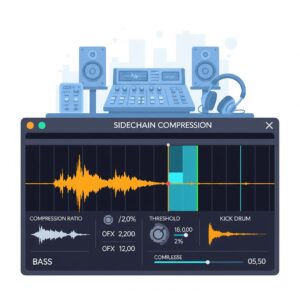Let’s be real — most tutorials stop at EQ, compression, and “use your ears.” And while fundamentals matter (a lot), sometimes you need to throw the rulebook out the window to unlock the kind of mixes that make people say: “Wait…how did you do that?”
Whether you’re trying to get your 2-track to hit harder, make vocals leap out of the speakers, or just break out of your creative rut, these unconventional mixing techniques might just change the way you hear music forever.
🔥 1. Sidechain Everything (Not Just the Kick) 
We all know the classic trick: sidechain the bass to the kick to get that bounce. But why stop there?
Try this:
-
Sidechain the reverb return of your lead vocal to the dry vocal itself.
-
Sidechain synth pads to the snare to give your transients more room.
The result? A mix that breathes, moves, and feels alive without over-compression.
🌌 2. Automate Your Stereo Image
Stereo width isn’t just for choruses anymore. Instead of setting a static stereo field, automate panning and stereo widening throughout the song.
-
Narrow the verses for intimacy.
-
Gradually widen the pre-chorus.
-
Go full IMAX on the hook.
Using plugins like Soundtoys PanMan, Waves S1, or Ozone Imager, you can add dynamic width shifts that trick the ear and elevate your arrangement without adding a single extra track.
 🎙️ 3. Reamp Your Vocals Through a Guitar Amp (Yes, Really)
🎙️ 3. Reamp Your Vocals Through a Guitar Amp (Yes, Really)
Want gritty, textured vocals that cut through dense instrumentals?
Try this:
-
Send your processed vocal through a real amp (or use a plugin like Amp Room, Guitar Rig, or Waves GTR).
-
Blend it back in underneath your clean vocal.
-
Use it like a parallel layer.
This technique adds harmonic complexity and character that EQ and saturation alone can’t touch. Great for hip-hop, alt-pop, or any genre that lives in the edges.
⏪ 4. Reverse Reverb Done Right
This one’s old school — but still criminally underused. The trick? Use reverse reverb as a transition, not just a sound effect.
Here’s a step-by-step:
-
Duplicate the vocal.
-
Add a lush reverb to the duplicate.
-
Bounce that reverb to audio.
-
Reverse it.
-
Line it up to start before the dry vocal.
Now your vocal doesn’t just start — it emerges from the mist.
Pro tip: Try this on snares or FX one-shots, too.
🧊 5. Use Bitcrushing as a Dynamic Effect
Bitcrushers are usually thought of as lo-fi or niche. But using them dynamically opens up wild creative doors.
Ideas:
-
Automate bitcrushing on ad-libs during the outro.
-
Use it subtly on parallel drums for extra texture.
-
Turn it on and off during fills to create sudden, glitchy shifts.
Plugins like Decimort, CrushShaper, or even Ableton’s stock Bitcrusher can be devastating in the right hands.
🚨 Bonus: Mix with No Reverb (At First)
This sounds insane, but trust: Mix your whole track dry first.
Why? Because too often we hide flaws under lush reverb tails and delays. If your mix doesn’t slap dry, it probably won’t slap wet either.
Get your EQ, levels, and dynamics right. Then, when you add reverb — you’ll feel it, not just hear it.
✍️ Final Thought
The best engineers break the rules after mastering them. Unconventional mixing isn’t about being weird for weird’s sake — it’s about being fearless enough to experiment.
So next time you open your DAW, try one of these off-the-wall techniques. You might end up with something you’ve never heard before… and that’s where the real magic lives.
👇 What’s your go-to unconventional mix move? Drop it in the comments.
Or if you’re looking to level up your sound, book a session with an elite mixing engineer on EngineEars — where creative meets professional, every time.
